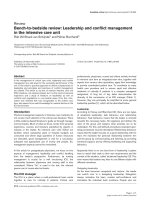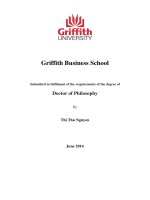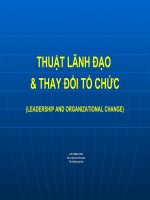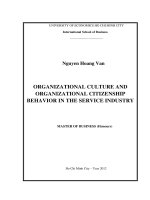Transformational leadership and organizational innovation
Bạn đang xem bản rút gọn của tài liệu. Xem và tải ngay bản đầy đủ của tài liệu tại đây (114.66 KB, 39 trang )
TRANSFORMATIONAL LEADERSHIP AND
ORGANIZATIONAL INNOVATION: A STUDY OF
MNCs IN MALAYSIA
OOI HUI YING
UNIVERSITI SAINS MALAYSIA
2009
DECLARATION
I hereby declare that the project is based on my original work except for quotations and
citations which have been duly acknowledged. I also declare that it has not been previously or
concurrently submitted for any other degree at USM or any other institutions.
____________________________
(Signature)
NAME: OOI HUI YING
DATE: 15/07/2009
TRANSFORMATIONAL LEADERSHIP AND ORGANIZATIONAL INNOVATION:
A STUDY OF MNCs IN MALAYSIA
By
Ooi Hui Ying
(Pauline)
Research Report Submitted in Partial Fulfillment of the Requirement of the
Degree of Master of Business Administration (MBA)
UNIVERSITI SAINS MALAYSIA
2009
i
DEDICATION
~~ To My Beloved Mum and Dad – Lucy & Michael ~~
For their love, care and sacrifices
~~ To My Beloved Sisters – Vivian & Irene~~
For their love and encouragement
To All My Dear Friends & Colleagues
For their understanding and cooperation
ii
ACKNOWLEDGEMENT
By the grace of God, I’m thankful to have the opportunity to further my studies at the
Universiti Sains Malaysia since July 2007 to present.
I would like to thank my beloved parents for their everlasting love, sacrifices and
prayers. They have taught me to give my best in what I do, and be strong through adversity.
Dad has always inspired me with his thirst for knowledge by constantly reading and learning
while mum’s virtue of patience and faith has always been admirable. I appreciate their
understanding when I’ve not been able to travel home more often and spend more quality
time with them due to work and studies. Thank you Mum & Dad! Not forgetting my two
darling sisters – Vivian and Irene who are the sunshine of my life. No matter near or far, they
have always stuck with me through thick and thin. Thank you for keeping me strong and
alive!
I would also like to extend my gratitude to my friends and my fellow course mates for
their generous support and help provided. A special note of thanks to Nicholas Lim who had
helped me out in the distribution and collection of questionnaires. His contribution and
support is very much appreciated for this would not be feasible without his assistance.
My heartfelt appreciation goes to my dedicated supervisor, Dr. Daisy Kee Mui Hung,
who had constantly rendered her extensive support to me throughout my semesters in
completing this research. She had gone the extra mile in accommodating to my irregular
work hours by having discussions with me after her working hours. Without her passion,
dedication and guidance in my learning process, this thesis would not have been made
possible. It was her persistency and consistency which kept me on track. Thank you for your
time and remarkable effort!
iii
TABLE OF CONTENTS
Title
i
Dedication
ii
Acknowledgement
iii
Table of contents
iv
Appendices
viii
List of Tables
ix
List of Figures
xi
Abstrak
xii
Abstract
xiii
Chapter 1
Chapter 2
1.0 INTRODUCTION
1
1.1 Background
1
1.2 Problem Statement
4
1.3 Research Objectives
6
1.4 Research Questions
7
1.5 Significance of Study
7
1.6 Definition of Key Terms
10
1.7 Organization of Remaining Chapters
11
2.0 REVIEW OF LITERATURE
2.1 Transformational Leadership
13
13
2.1.1
Idealized Influence
16
2.1.2
Inspirational Motivation
16
2.1.3
Individualized Consideration
17
2.1.4
Intellectual Stimulation
18
iv
2.2 Team Cohesiveness
19
2.3 Organizational Innovation
23
2.3.1
Participative Safety
25
2.3.2
Vision
26
2.3.3
Support for Innovation
26
2.3.4
Task Orientation
27
2.3.5
Social Desirability
28
2.4 Theoretical Framework
29
2.5 Hypotheses Development
29
2.5.1
Transformational Leadership and
30
Organizational Innovation
2.5.2
Transformational Leadership and Team
31
Cohesiveness
2.5.3
Team Cohesiveness and Organizational
31
Innovation
2.6 Summary
Chapter 3
33
3.0 RESEARCH METHODOLOGY
34
3.1 Research Design
34
3.2 Research Population and Samples
35
3.3 Data Collection and Procedure
36
3.4 Measures
38
3.4.1
Transformational Leadership
39
3.4.2
Team Cohesiveness
40
v
3.4.3
Chapter 4
Organizational Innovation
3.5 Data Analysis
42
3.6 Summary
44
45
4.0 RESULTS
4.1 Profile of Respondents
45
4.2 Goodness of Measures
48
4.2.1
4.2.2
4.2.3
Factor analysis
48
4.2.1.1 Transformational Leadership
49
4.2.1.2 Team Cohesiveness
53
4.2.1.3 Organizational Innovation
56
Reliability Analyses
59
4.2.2.1 Transformational Leadership
59
4.2.2.2 Team Cohesiveness
60
4.2.2.3 Organizational Innovation
61
Correlation Analysis
62
4.3 Hypotheses Testing
65
4.3.1
Test for Hypothesis 1
65
4.3.2
Test for Hypothesis 2
67
4.3.3
Test for Hypothesis 3
68
4.3.4
Test for Hypothesis 43
69
4.4 Summary
Chapter 5
42
71
5.0 DISCUSSIONS AND CONCLUSION
73
5.1 Recapitulation of Study Findings
73
vi
5.2 Discussion and Interpretation
5.2.1
Impact of Transformational Leadership
76
76
and Organizational Innovation
5.2.2
Impact of Transformational Leadership
79
and Team Cohesiveness
5.2.3
Impact of Team Cohesiveness on
80
Organizational Innovation
5.2.4
Effect of Team Cohesiveness between
82
Transformational Leadership and
Organizational Innovation
5.3 Implications
83
5.4 Limitations
86
5.5 Areas of Future Research
87
5.6 Conclusion
88
References
90
Appendices
103
vii
APPENDICES
Appendix A: Survey Cover Letter and Questionnaire
103
Appendix B: SPSS Output - Descriptive Statistics of Demographic Data
108
Appendix C: SPSS Output – Factor Analysis
114
Appendix D: SPSS Output – Reliability Analysis
145
Appendix E: SPSS Output – Variables Correlation Analysis
167
Appendix F: SPSS Output – Regression Analysis
169
viii
LIST OF TABLES
Table 3.1
Profile of Organizations
35
Table 3.2
Questionnaire Response Rate
37
Table 3.3
Distribution of Questionnaire Items
38
Table 3.4
Modification of Original Group Environment Questionnaire
41
Table 4.1:
Descriptive Analysis of Respondents’ Demographic Data
45
Table 4.2:
Rotated Factors and Item Loadings of Transformational
50
Leadership
Table 4.3:
Rotated Factors and Item Loadings of Team Cohesiveness
54
Table 4.4:
Rotated Factors and Item Loadings of Organizational
57
Innovation
Table 4.5:
Summary of Cronbach’s Alpha for Transformational
60
Leadership
Table 4.6:
Summary of Cronbach’s Alpha for Team Cohesiveness
61
Table 4.7:
Summary of Cronbach’s Alpha for Organizational
61
Innovation
Table 4.8:
Correlation between variables
64
Table 4.9:
Summary of Regression Analysis for Transformational
66
Leadership and Organizational Innovation
Table 4.10:
Summary of Regression Analysis for Transformational
67
Leadership and Team cohesiveness
Table 4.11:
Summary of Regression Analysis for Team Cohesiveness
ix
69
and Organizational Innovation
Table 4.12:
Summary of Mediating Effect Between Individualized
70
Consideration and Intellectual Stimulation And Support
for Innovation and Task Orientation
Table 4.13:
Summary of Mediating Effect Between Rationalized
71
Optimism And Mutual Understanding and Expectations
Table 4.14:
Summary of Hypotheses Results
x
72
LIST OF FIGURES
Figure 2.1. Framework of the study
29
xi
ABSTRAK
Kepantasan dalam perubahan dan perkembangan dunia semakin mendadak.
Sememangnya, innovasi memainkan peranan yang penting. Kualiti kepimpinan seseorang
pemimpin juga menggalakkan aktiviti yang melibatkan innovasi. Kajian ini mengkaji
perhubungan antara kepimpinan transformasi dan inovasi organisasi. Selain itu, kajian ini
juga menyiasat kohesif pasukan yang memainkan peranan sebagai dalam hubungan ini.
Hasil kajian ini menunjukkan bahawa perhubungan kepimpinan transformasi dan
inovasi organisasi menunjukkan hubungan yang positif walaupun tidak sepenuhnya.
Seterusnya, seperti mana yang dijangkakan daripada ujian pembolehubah penyederhana,
kohesif pasukan memang memainkan peranan sebagai pembolehubah penyederhana,dalam
menggalakkan inovasi organisasi. Perhubungan di antara kepimpinan transformasi dan
kohesif pasukan juga menunjukkan jalinan yang positif tetapi tidak sepenuhnya. Hubungan
antara kohesif pasukan daninovasi organisasi. juga tidak melainkan, di mana terdapat sifat
positive dalam hubungan itu. Akhirnya, permerhatian kajian ini turut mendapati bahawa
jalinan antara kohesif pasukan dan inovasi organisasi juga menunjukkan hubungan yang
positif.
Akhir sekali kajian ini memberikan implikasi kepada pengurus dan pemimpin hari ini
yang bergerak ke arah innovasi.
xii
ABSTRACT
The fast paced global changing environment and competition among companies to
obtain competitive advantage warrant better leadership qualities and innovation effort. The
purpose of this research was to examine the relationship between transformational leadership
and organizational innovation. The study also examined the mediator role played by team
cohesiveness on the relationship of transformational leadership and organizational
innovation.
The results of this study showed that the impact of transformational leadership was
partially positive and significant on organizational innovation. However, individualized
consideration and intellectual stimulation dimension of transformational leadership
demonstrated a greater impact on organizational innovation. There was a partially positive
and significant relationship between transformational leadership and team cohesiveness. In
addition to that, organizational innovation was predicted by team cohesiveness. The
mediation test suggested that team cohesiveness did play a mediating role in the relationship.
The relationship between rationalized optimism and mutual understanding and expectations
was partially mediated by team cohesiveness, while individualized consideration and
intellectual stimulation and support for innovation and task orientation was fully mediated by
team cohesiveness.
Lastly, this research provided several implications to aspiring managers and leaders as
organizations are moving towards innovation.
xiii
CHAPTER 1
INTRODUCTION
___________________________________________________________________________
Chapter 1 introduces the general background on leadership and innovation as well as
an overview of the scenario in Malaysia. Some problem statements pertaining to the research
topic in question are discussed to address the gap in present literature. Research objectives
and research questions guide the direction of this study in order to provide some significance
to the pool of existing literature. Definition of key terms aims to provide useful meaning on
some frequently used terms in this research. Finally, organization of remaining chapters listed
an overview of the remaining topics found in this report
1.1
Background
Leadership, as described by Yukl (2005) and Krause (2004) has a great influence on
the subordinates’ behavior to accomplish organizational goals. It involves an interaction
process between leaders and subordinates. Many researchers found that leadership style is
one of the most influential factors that have an impact on creativity behavior and performance
(Amabile, 1998; Jung, 2001; Mumford & Gustafson, 1988), thus, affecting organizational
innovation.
Among the many types of leadership, Tucker and Russell (2004) commented that an
organization needs transformational leaders who provide new direction, inspiration, and
behaviors for their organizations. These leaders are the change-agents in the organization and
they are crucial in an ever-changing world. Apart from leadership factor, one of the important
1
factors in the success and competitive advantage of organizations lies in innovation
(Woodman, Sawyer & Griffin, 1993). Gumusluoglu and Ilsev (2008) highlighted that
transformational leadership has an impact on both individual and organizational level.
However, Oldham and Cummings (1996) concluded that the effect of transformational
leadership and creativity is at individual level, but the effect of innovation is at organizational
level. Innovation is regarded as important by organization because innovative outcome will
provide any organization the competitive advantage to stay profitable (Gianikis & McCue,
1997).
There are a few researchers studied leadership in the Malaysian context especially on
theoretical frameworks of leadership preferences, behaviors, and power influence (Ansari,
Ahmad and Aafaqi, 2004). Kennedy and Mansor (2000) found that due to cultural values and
beliefs, Malaysian leaders lack of self-serving attitude by placing the interest of subordinates
above themselves. A recent study by Kennedy (2002) reported that Malaysian managers rated
transformational leadership as a highly important contributor to outstanding leadership. In
other cultures and countries, many previous studies on transformational leadership were
found to have positive impacts on organization. Researchers such as Arnold, Barling and
Kelloway (2001), Bass, Jung, Avolio and Berson (2003), Hetland and Sandal (2003), as well
as Wofford, Whittington and Goodwin (2001) indicated that transformational leadership had
resulted in higher level of effectiveness and outcomes based on the followers’ appraisal.
Several studies were also found to be concentrated on the relationship between
transformational leadership and personality (Hetland & Sandal, 2003; Bono & Judge, 2000;
Roush & Atwater, 1992; Van Eron & Burke, 1992).
2
According to Bass (1985), the definition of the relationship between transformational
leader and subordinate includes four elements such as idealized influence, inspirational
motivation, individualized consideration and intellectual stimulation. In comparison to other
leadership types, demonstration of these elements among transformational leaders indicated
higher productivity and job satisfaction besides lower employee turnover rates (Masi &
Cooke, 2000; Sparks & Schenk, 2001; Medley & Larochelle, 1995). In Tichy and Devanna’s
(1990) study, transformational leadership is concerned with change, innovation and
entrepreneurship. The behavioral demonstration of transformational leadership elements is
believed to influence the recognition of needs for innovation, creation of new vision and
mission as well as implementation of change. It was suggested that innovation is determined
by interactions of individuals with other people and without the encouragement from
managers/leaders, subordinates are likely to terminate their effort (Zhou & Shalley, 2003;
Anderson, de Dreu & Nijstad, 2004). Therefore, it is necessary for organizations to
continuously innovate to stay profitable in light of the increasing business competition.
Nonetheless, little is known about the linkage between transformational leadership and
organizational innovation. The strong literature presence and positive outcome of
transformational leadership coupled with its suitability in adapting to the demands of
changing business world makes this leadership style an appealing one in the near future.
Thus, this research hopes to contribute to the existing literature on transformational
leadership and organizational innovation in the context of MNCs based in Malaysia. The
following section will elaborate more on the current problem statement.
3
1.2
Problem Statement
Globalization of economic environment and the increasing demand for varieties of
product features, quality and services have pressured companies to change the way
organizations function and respond. As a result, innovation effort is needed for organization
to stay competitive in the industry and for innovation to take place, organization need
effective leaders to transform the people.
The role of leadership as a determinant of organizational creativity and innovation has
become more important with the increasing intricacy of work processes and competitive
business environment (Dess & Picken, 2000). Furthermore, with rapid technological change,
globalization and evolution of product life cycles in today’s dynamic environment,
organizations cannot afford to ignore the emphasis in striving for creativity and innovation. In
fact, organizational creativity and innovation are more important than before for survival,
competition, growth and leadership to remain successful in the industry (Jung, Bass, Avolio
& Berson, 2003; Tierney, Farmer & Graen, 1999). Current issues facing Malaysian work
force is the growing deficits in skills and innovation (Rasiah, 2003). Institutional support
mechanisms for innovation were reported to be not on par with capabilities of Singapore,
Taiwan South Korea and Japan. Conklin and Cadieux (2006) found that Malaysian firms may
lack of the ability to encourage a risk-taking culture. Employees in MNCs such as 3M and
Qualcomm are frequently challenged to be creative and it has enabled them to produce
innovative and successful outcomes which become their competitive advantage (Jung et al.,
2003).
4
Existing studies reported positive influence of transformational leaders on innovation
(Keller, 1992; Waldman & Atwater, 1994) but little literature on organizational innovation
focusing on team level was found (West & Farr, 1989; Anderson & King 1990, 2002).
According to Mumford, Scott, Gaddis and Strange’s (2002) observation, the scarcity of
literature on how transformational leadership style affects innovative organizational climate
which further led to organizational innovation is surprising although many argued that
leadership is essential for innovation to happen. Organizational innovation occurs firstly at
individual level and subsequently at team level. Since previous empirical studies mostly
examined the effects of leadership role at individual level rather than at organization level
(Jung et al., 2003), this study investigate innovation at team level in order to bring individual
and organization together. Social and task interdependence are the basis that teams were
formed. Achievement of every team member influences the success of the team as a whole
which is then lead to organizational success. Team cohesiveness also plays a critical
motivational factor in influencing team performance (Weaver, Bowers, Salas & CannonBowers, 1997).
The available literature does not examine the mediating roles such as team
cohesiveness in the relationship of transformational leadership and organizational innovation
(Gumusluoglu and Ilsev, 2008). However, transformational leaders were found to influence
team cohesiveness by promoting higher attachment among members and drawing members
closer as a team in achieving shared goals (Korsgaard, Schweiger & Sapienza, 1995).
Individualized consideration attributes of transformational leadership seek to understand each
team member’s skills, characteristics and behaviors thereby driving them towards a
cooperative team apart from higher attachment among team members. Consequently, with
5
motivation and vision components of transformational leaders, effective team cohesiveness
can be cultivated so that individuals work together as a team to bring organizational
innovation to the next level. As shown in Rabin and Stenhauer (1988) study, team
cohesiveness indeed promotes organizational climate which influences innovation
Therefore, it is hoped that the present research on transformational leadership and
organizational innovation may be a rewarding direction for further exploration.
1.3
Research Objectives
Organizational innovation has recently received greater attention and emphasis in
multinational companies (MNCs) due to the need for new products and service to survive in
competitive business environment. However, execution of innovative ideas at organizational
level is dependent on various factors such as encouraging an innovative culture. Schein
(1992) pointed out that organizational leaders are a key source of influence on organizational
culture. Among the leadership styles, it was found that transformational leadership showed
positive impact on organizational innovation (Keller, 1992; Waldman & Atwater, 1994).
As most of the researches transpire in the Western countries, this study attempts to
study on MNCs in Malaysia based on the following research objectives:
1) Investigate the relationship between Transformational Leadership and Organizational
Innovation.
6
2) Investigate the relationship between Transformational Leadership and Team
Cohesiveness
3) Investigate the relationship between Team Cohesiveness and Organizational
Innovation
4) Investigate if Team Cohesiveness mediates the relationship between Transformational
Leadership and Organizational Innovation.
1.4
Research Questions
Several research questions are posed for the purpose of this study in order to attain the
objectives mentioned above.
1) How does Transformational Leadership relate to Organizational Innovation?
2) How does Transformational Leadership relate to Team Cohesiveness?
3) How does Team Cohesiveness relate to Organizational Innovation?
4) How does Team Cohesiveness mediate the relationship between Transformational
Leadership and Organizational Innovation?
1.5
Significance of study
There are few empirical studies which examine the link specifically between
transformational leadership and organizational innovation (Jung et al., 2003; Gumusluoglu
and Ilsev, 2008; Dionne, Yammarino, Atwater & Spangler, 2003). Most of the available
literatures are mainly in the context of organizations in western countries and none was found
to be specifically in the Malaysian context. Lee and Lee (2006) reported the results from
7
national innovation surveys in Malaysia which suggests that 21-42% out of the total firms
surveyed are innovators. Since transformational leadership is a new paradigm of leadership
which has recently become a popular research topic, it is feasible to study how this leadership
style influences organizational innovation in Malaysia. Thus, this study will help to fill in the
gap of present literature
Scholars have suggested that transformational leadership future research direction
should explore into the various mediating roles and linkages with organizational innovation
(Gumusluoglu and Ilsev, 2008; Jung et al., 2003; Mumford et al., 2002). They propose that
future research should be based on more cross-analysis that takes leadership styles, group
norms, various organizational and environmental characteristics, and motivational
characteristics into consideration. The reason is that previous studies had focused on
organizational innovation as a whole and similar mode of reasoning should apply at the level
of organizational subunits. The study on team cohesiveness or team cohesion as a mediator
between transformational leadership and organizational innovation is relatively new. It was
suggested as one of the group processes for future research in previous literature reviews
(Gumusluoglu and Ilsev, 2008; Jung et al., 2003; Mumford et al., 2002). Gumusluoglu and
Ilsev (2008) proposed to future researchers that mediating influences such as team
cohesiveness would potentially create an impact on the relationship between transformational
leadership and organizational innovation.
Based on the proposal of past literature and existing literature gap, the framework of
this study is developed with the objective to seek empirical evidence on the mediating effect
of team cohesiveness on transformational leadership and organizational innovation at team
8
level. Hence, this research is perceived be a significant contribution to the literature wherein
empirical evidence and findings can be created for academic and management inference
purposes. It is hoped that the present study may provide the basis for further exploration in
other areas of transformational leadership and organizational innovation.
9
1.6
Definition of Key Terms
Transformational Leadership
Transformational leadership was defined as inspiring followers to commit to a shared vision
and goals for an organization or unit. Leaders also challenge subordinates to be innovative
problem solvers, and develop followers’ leadership capacity via coaching, mentoring, and
provision of both challenge and support (Bass & Riggio, 2006).
Idealized Influence
It is an attribute of a transformational leader who is admired, respected, and trusted.
Followers tend to identify themselves with the leaders and want to emulate their leaders
(Avolio & Bass, 2004)
Individualized Consideration
It refers to the extent to which transformational leaders treat their followers as individuals
(Avolio & Bass, 2004).
Intellectual Stimulation
The leader broadens and elevates the interests of his or her employees and stimulates
followers to think about old problems in new ways (Avolio & Bass, 1995).
Inspirational Motivation
How effective leaders are at getting followers to attain higher goals and expectations (Avolio
& Bass, 1995).
10









